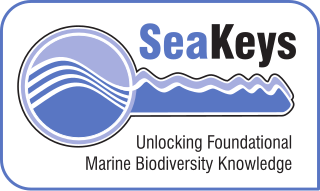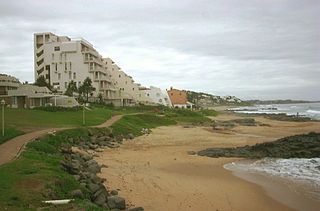Related Research Articles

KwaZulu-Natal is a province of South Africa that was created in 1994 when the Zulu bantustan of KwaZulu and Natal Province were merged. It is located in the southeast of the country, with a long shoreline on the Indian Ocean and sharing borders with three other provinces and the countries of Mozambique, Eswatini and Lesotho. Its capital is Pietermaritzburg, and its largest city is Durban. It is the second-most populous province in South Africa, with slightly fewer residents than Gauteng.

Durban, nicknamed Durbs, is the third most populous city in South Africa after Johannesburg and Cape Town and the largest city in KwaZulu-Natal. Durban forms part of the eThekwini Metropolitan Municipality, which includes neighbouring towns and has a population of about 3.44 million, making the combined municipality one of the largest cities on the Indian Ocean coast of the African continent. Durban was also one of the host cities of the 2010 FIFA World Cup.
Ezemvelo KZN Wildlife is a governmental organisation responsible for maintaining wildlife conservation areas and biodiversity in KwaZulu-Natal Province, South Africa. Their headquarters is in Queen Elizabeth Park situated on the northern slopes of Pietermaritzburg, the KwaZulu-Natal provincial capital. Prior to 1994, it was known as the Natal Parks Board.
KwaZulu-Natal is one of the most diverse provinces in South Africa in terms of its fauna and flora. Many of its wide variety of ecosystems have been preserved as parks and reserves, which are popular tourist attractions. Ezemvelo KZN Wildlife is a governmental agency that maintains the wildlife conservation areas in the province.

Margate is a coastal resort town in the Kwa-Zulu Natal province, about 20 kilometres southwest of Port Shepstone. The river which flows into the sea at Margate is called "Nkhongweni" (place of entreaty) as the original inhabitants of the area were reputed to be so mean resulting in travellers begging for hospitality.

Port Shepstone is a large town situated on the mouth of the Mzimkhulu River, the largest river on the KwaZulu-Natal South Coast of South Africa. It is located halfway between Hibberdene and Margate and is positioned 120 km south of Durban. It is the administrative, educational and commercial centre for southern Natal.

Amanzimtoti is a coastal town just south of Durban, KwaZulu-Natal, South Africa. The town is well known for its warm climate and numerous beaches, and is a popular tourist destination, particularly with surfers. The annual sardine run attracts many to the Toti beaches.

Umzumbe is a seaside resort situated at the mouth of the Mzumbe River (bad kraal) in KwaZulu-Natal, South Africa. The name of the river is derived from a band of Hlongwa cannibals who occupied the valley. The Hlongwa was almost wiped out by the Zulu king Shaka in 1828.

uShaka Marine World is a 16-hectare (40-acre) theme park that opened on 30 April 2004 in Durban, KwaZulu-Natal, South Africa. It has a total capacity of 4.6 million gallons containing 10,000 animal species.

The KwaZulu-Natal sardine run of southern Africa occurs from May through July when billions of sardines – or more specifically the Southern African pilchard Sardinops sagax – spawn in the cool waters of the Agulhas Bank and move northward along the east coast of South Africa. Their sheer numbers create a feeding frenzy along the coastline. The run, containing millions of individual sardines, occurs when a current of cold water heads north from the Agulhas Bank up to Mozambique where it then leaves the coastline and goes further east into the Indian Ocean.

Umlazi is a township in KwaZulu-Natal, South Africa, located south-west of Durban. Organisationally and administratively it forms part of the eThekwini Metropolitan Municipality and its South Municipal Planning Region.
The Nguni people are a Bantu ethnic group from South Africa, with off-shoots in neighbouring countries in Southern Africa. Swazi people live in both South Africa and Eswatini, while Northern Ndebele people live in both South Africa and Zimbabwe.

The KwaZulu-Natal Sharks Board (KZNSB), previously the Natal Sharks Board and Natal Anti-Shark Measures Board is an organisation that maintains a "shark control" program off the coast of KwaZulu-Natal Province, South Africa, at 37 places. The purpose of the nets and drum lines is to reduce the number of shark attacks. It was founded as a statutory body in 1962, when the city of Durban's netting operations were extended to other parts of the coast in the then Natal Province. It is headquartered in uMhlanga, north of Durban.
Kwa-Bulawayo was the royal kraal of Shaka Zulu, and as such was the capital of the early Zulu empire. It was founded after Shaka's conquest of the Ndwandwe kingdom, in around 1820. During the conflict, Shaka made a stand outside Kwa-Bulawayo, facing two thousand Ndwande who returned from cattle rustling, in addition to five hundred more who survived the battle at Gqokli.

The South African Hockey Association (SAHA) is the governing body of field hockey in South Africa. It is affiliated to FIH International Hockey Federation and AHF African Hockey Federation. The Head Office of SAHA is in Illovo, Johannesburg, South Africa.

KwaZulu-Natal South Coast is a region on the southern coast of KwaZulu-Natal, South Africa. It stretches from Scottburgh in the north to Port Edward in the south and Harding in the west. The coast is governed by the Ugu District Municipality.
The marine protected areas of South Africa are in an area of coastline or ocean within the exclusive economic zone (EEZ) of the Republic of South Africa that is protected in terms of specific legislation for the benefit of the environment and the people who live in and use it. An MPA is a place where marine life can thrive under less pressure than unprotected areas. They are like underwater parks, and this healthy environment can benefit neighbouring areas.
The following index is provided as an overview of and topical guide to the protected areas of South Africa:

SeaKeys is a large collaborative marine biodiversity project funded through the Foundational Biodiversity Information Program in South Africa. The purpose of the project is to collect and distribute genetic, species and ecosystem information relating to marine biodiversity in southern Africa, which may be used to support informed decision-making about the marine environment.

The KwaZulu-Natal North Coast is a region on the northern coast of KwaZulu-Natal, South Africa. It stretches from Thukela Mouth in the north to Ballito in the south. The coast is governed by the iLembe District Municipality.
References
- 1 2 3 4 5 6 "Home". www.saambr.org.za. Retrieved 16 May 2019.
- ↑ McQuaid, CD. (2010). "Balancing science and politics in South African marine biology" (PDF). South African Journal of Science. 106 (11/12). doi: 10.4102/sajs.v106i11/12.467 .
- ↑ "Oceanographic Research Institute (ORI)". www.saambr.org.za. Retrieved 16 May 2019.
- ↑ "uShaka Sea World". www.saambr.org.za. Retrieved 16 May 2019.
- ↑ "uShaka Sea World Education". www.saambr.org.za. Retrieved 16 May 2019.
- 1 2 "South African Association for Marine Biological Research". www.devex.com. Retrieved 16 May 2019.
- ↑ "South African Association for Marine Biological Research (SAAMBR) 57th Annual General Meeting". South African Government Media Advisories. 8 November 2010. Retrieved 15 May 2019.